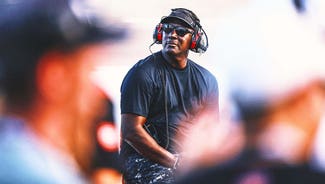
Since economic downturn, NASCAR fighting to get fans back
RICHMOND, Va. (AP) At the zenith of its popularity a decade or so ago, many NASCAR tracks could count on sellout crowds for every Sprint Cup Series race. It seemed like the only real effort they had to make was simply to open the gates.
That has changed dramatically during the economic downturn, and put track presidents and other administrators back in the position of promoters trying to fill seats that once sold themselves.
Martinsville Speedway President Clay Campbell equated the present challenge of attracting fans to NASCAR's formative years.
''You promoted your event and did things to attract crowds and then it got to the point where I think a lot of us were guilty of slacking off because things were going really well,'' he said. ''Now we're back in that day where we do things to entice people to come to our events.''
The results have been great for fans who show up to find free concerts and other amenities. But the enthusiasm hasn't led to packed houses. Many tracks have removed sections of grandstands, and they still don't look full on race day, and there has been a drop in television ratings, too. Overnight ratings are down by double digits for seven of the 13 Sprint Cup races so far this year, and six hit a multi-year low. Still, the Coca-Cola 600 was the third-most watched sporting event last weekend behind the Indianapolis 500 and Game 7 of the NBA Western Conference finals despite an 11 percent decline in viewership.
Some wonder if NASCAR's day in the sun has passed. Track officials instead see a changing, younger fan base that needs to be enticed to watch live racing - and spend money.
Dover International Speedway President Mike Tatoian said the trend is not as alarming as one might think.
''I think it's hard to pinpoint one thing that's caused this attendance decline,'' Tatoian said. ''I don't think it was realistic for everyone to think it was going to continue on that meteoric rise or stay at that level. I always say our level of wellness has just been adjusting.''
At Richmond International Raceway, ticket requests numbered upward of 160,000 in the late 1990s and 33 races in a row in the top series sold out over more than 16 years. Since then, the track has reduced the capacity of its grandstand from more than 112,000 seats to about 60,000 - and still can't sell out. That despite free parking, the ability for fans to bring their own food and drinks, and initiatives that allow them to walk on the track until nearly race time.
''We have to get back to putting fans into those unique experiences,'' track President Dennis Bickmeier said.
Despite the economy, the Virginia track says, fan surveys don't suggest an issue with the tickets.
''One of the things that really jumped out to us in the data was that people weren't complaining about the price of their ticket, but what they asked for was more value for their ticket,'' Bickmeier said. The track's first race of the season on April 24 drew far less than a capacity crowd despite ideal weather, an afternoon start time and expectations of great racing. ''So then we were able to go back and ask, what's more value. They wanted more to see and do.''
Among the changes: A new family-friendly seating area in Turn 4 where no alcohol is sold and ushers work to keep the atmosphere OK for young children.
As for the main attraction, rules changes have helped produce some of the best racing the Sprint Cup series has ever seen, including the closest finish in Daytona 500 history. There was a last-lap nudge and pass for the win for Carl Edwards at Richmond, too.
Bickmeier hopes the excitement of that finish will be the start of something bigger. The track's next race comes on Saturday night, Sept. 10, and is the last chance for drivers to make it into the Chase for the championship.
General manager Jerry Caldwell of Bristol Motor Speedway said NASCAR crowds may be down but are still huge.
The Tennessee track, which once drew about 150,000 fans to races in the premier series, once had a sellout streak of 55 races. It does not release attendance figures, but was about half full for its event on April 17, despite sunny, 72-degree weather.
Caldwell suggested it might be time to stop looking at attendance figures from the pre-recession heyday and remember that other sporting events also struggle with empty seats. He expects Bristol's late race on Saturday night, Aug. 20, to be well attended.
At Martinsville, a small town in southwest Virginia near the North Carolina line, the track used to make seats on its backstretch available on race day, and had people camping out overnight to be in line to buy them. Since pit stalls were moved and a garage was built, those seats are no longer of much value and the track drapes the backstretch seating in advertising banners.
Like Caldwell, Campbell said it's important to put things in perspective.
''There for a while, crowds were much larger than they are now, but now we can focus on providing the people here a great experience,'' he said. ''I think in the long run, it's working out. It's not what we were used to in the late `80s and early `90s, but we're still drawing pretty big crowds for a sporting event, much larger than other sports.''
---
AP Sports Writer Dan Gelston contributed to this report.
---
Online: AP's racing page: www.racing.ap.org
---
Follow Hank on twitter: www.twitter.com/hankkurzjr

